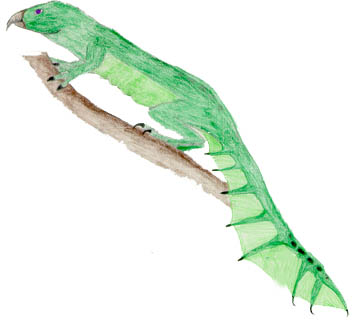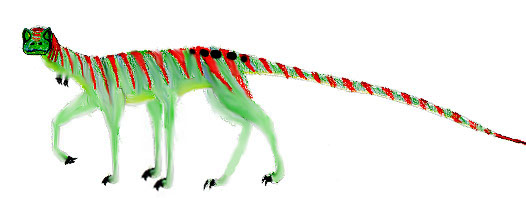The Ordina
The Ordina are an animal
group unique to Rona. They are related to the ploidomorphs though they are believed to have shared a common ancestor more than 300 million years ago.
Like the ploidomorphs, they are creatures with a hard endoskeleton and thus members of the Chakorrakta that is a large group similar to terran vertebrates.
They have lost the ancestral haplo-diplontic life cycle that characterizes ploidomorphs and operate as an essentially diplontic life cycle.
However the gamete cells retain some structures that identify them as once free living organisms and the ordina do not have separate sexes.
The unique characteristic of the Ordina is their breathing system through holes on either side of the back which open into small chambers filled with blood vessels.
This was an evolutionary innovation as the ordina were the first animals on Rona to adapt to life on land. Ordina also retain the large number of limbs of the ancestral Chakorrakta.
All Ordina have a larval stage that is something like a worm. These larva aerate the soil
and consume dead organic matter in the soil. A few species of Ordina never leave this larval stage.
Upon reaching a certain size and age
they metamorphose into the lizard-like adults. The adults feed on many different things
and live in diverse climates.Example Species
Cymeadiah
Height: 5 inches
Length:4ft
Weight: 10 lb
 The Cymediah is one of the commonest representative of
the Ordina. Most cymediah species feed on small animals and fruits though some are exclusively carnivores while others are may be exclusively herbivorous.
It lives in underground burrows, leaving only at night to feed.
The Cymediah is one of the commonest representative of
the Ordina. Most cymediah species feed on small animals and fruits though some are exclusively carnivores while others are may be exclusively herbivorous.
It lives in underground burrows, leaving only at night to feed.
Duru
Height: 4 in
Length: 3ft
Weight: 5lbs
 The Duru is the Ronan equivalent of a flying squirrel.
It's "tail" is actually a continuation of it's backbone. The
clawed extentions between the webs of the "tail" are
actually reduced legs.
The Duru is the Ronan equivalent of a flying squirrel.
It's "tail" is actually a continuation of it's backbone. The
clawed extentions between the webs of the "tail" are
actually reduced legs.The Duru feeds on fruits and nuts
and glides between trees to feed.
Rafia
Height: 4ft
Length: 6ft
Weight: 70 lbs
 Rafia are medium sized quick and agile herbivores of the plains and forest.
There are a number of different species, the largest being slightly smaller than a deer with the smallest being the size of a housecat.
They typically move in herd and use speed to avoid predators. Their long tails
act as a counterbalance to help them turn at high speeds. Their legs have been reduced to a mere 3 main pairs but a few more pairs can be seen along the elongated neck which are used during mating.
Rafia are medium sized quick and agile herbivores of the plains and forest.
There are a number of different species, the largest being slightly smaller than a deer with the smallest being the size of a housecat.
They typically move in herd and use speed to avoid predators. Their long tails
act as a counterbalance to help them turn at high speeds. Their legs have been reduced to a mere 3 main pairs but a few more pairs can be seen along the elongated neck which are used during mating.
Back to the home world
 Rafia are medium sized quick and agile herbivores of the plains and forest.
There are a number of different species, the largest being slightly smaller than a deer with the smallest being the size of a housecat.
They typically move in herd and use speed to avoid predators. Their long tails
act as a counterbalance to help them turn at high speeds. Their legs have been reduced to a mere 3 main pairs but a few more pairs can be seen along the elongated neck which are used during mating.
Rafia are medium sized quick and agile herbivores of the plains and forest.
There are a number of different species, the largest being slightly smaller than a deer with the smallest being the size of a housecat.
They typically move in herd and use speed to avoid predators. Their long tails
act as a counterbalance to help them turn at high speeds. Their legs have been reduced to a mere 3 main pairs but a few more pairs can be seen along the elongated neck which are used during mating. The Cymediah is one of the commonest representative of
the Ordina. Most cymediah species feed on small animals and fruits though some are exclusively carnivores while others are may be exclusively herbivorous.
It lives in underground burrows, leaving only at night to feed.
The Cymediah is one of the commonest representative of
the Ordina. Most cymediah species feed on small animals and fruits though some are exclusively carnivores while others are may be exclusively herbivorous.
It lives in underground burrows, leaving only at night to feed.
 The Duru is the Ronan equivalent of a flying squirrel.
It's "tail" is actually a continuation of it's backbone. The
clawed extentions between the webs of the "tail" are
actually reduced legs.
The Duru is the Ronan equivalent of a flying squirrel.
It's "tail" is actually a continuation of it's backbone. The
clawed extentions between the webs of the "tail" are
actually reduced legs.